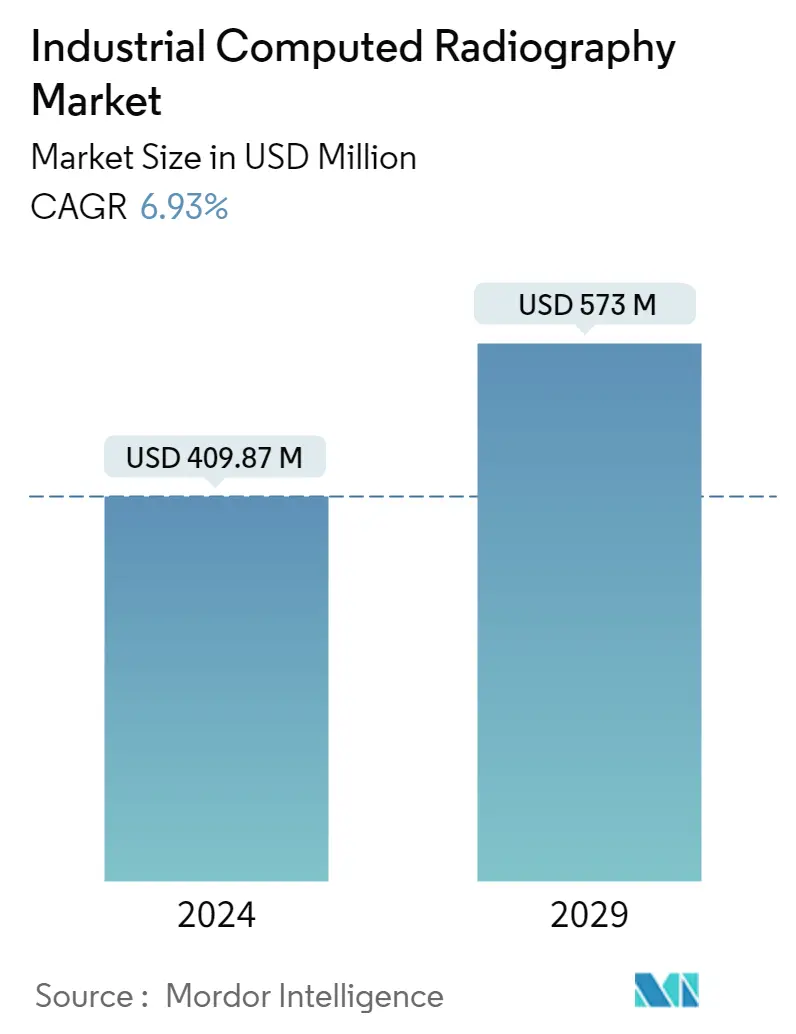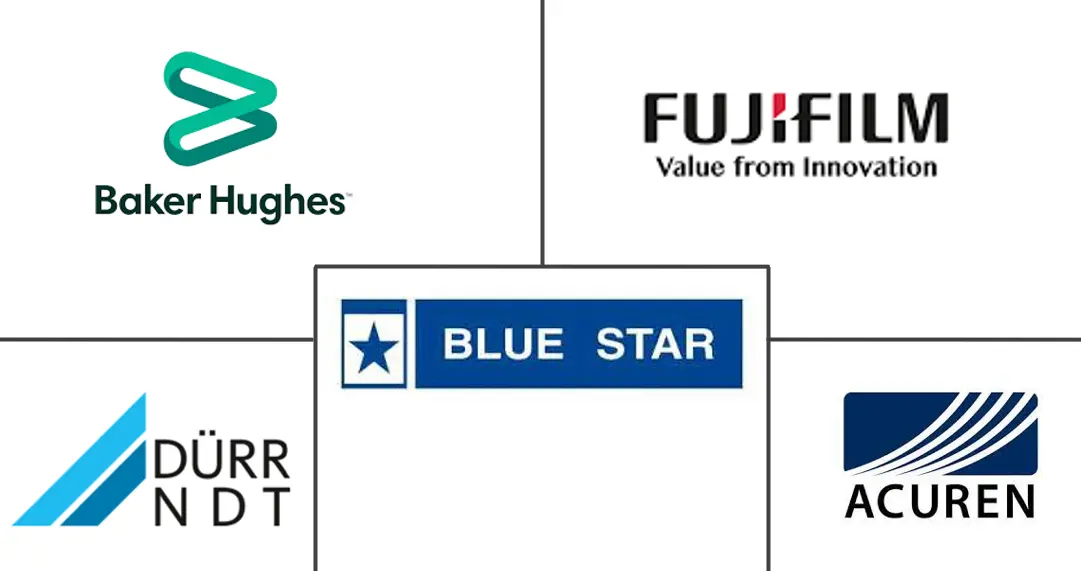
| Study Period | 2019 - 2029 |
| Market Size (2024) | USD 409.87 Million |
| Market Size (2029) | USD 573.00 Million |
| CAGR (2024 - 2029) | 6.93 % |
| Fastest Growing Market | Asia Pacific |
| Largest Market | North America |
| Market Concentration | Low |
Major Players
*Disclaimer: Major Players sorted in no particular order |
Industrial Computed Radiography Market Analysis
The Industrial Computed Radiography Market size is estimated at USD 409.87 million in 2024, and is expected to reach USD 573 million by 2029, growing at a CAGR of 6.93% during the forecast period (2024-2029).
Computed radiography technology offers enormous advantages for inspection tasks, and the use of consumables is virtually eliminated, further reducing the time to produce an image. These factors are expected to increase market adoption.
- Minute details are visible and analyzable due to a higher dynamic range than a film in traditional x-ray machines. Further, it provides a simplified workflow, a safer working environment for operators, and a more environmentally-friendly chemical-free process.
- Various computed radiography vendors have improved digital radiography scanners, phosphor imaging plates, and software programs. As a result, new products have been introduced that directly meet the needs of industries such as aerospace and defense, oil and gas, etc.
- Various products on the market use cylinder or flat panel scanners with software ranging from 14-bit logarithmic to 16-bit linear. Minimum pixel sizes range from 12.5-25, 25-35, 35-70, and 70-100 pixels, resulting in significantly increased essential spatial resolution, signal-to-noise ratio values, and grey values to fulfill many of the current standards. These have a substantial impact on the likelihood of detecting faults in materials.
- Current CR scanners and phosphor imaging plates can scan resolutions of 12.5 - 25 (equal to D4/IX50 in radiography film). These fulfill the sensitivity criteria in specifications, such as 2% radiographic sensitivity or greater, and the likelihood of fault identification has increased significantly.
- However, high installation costs and further technological improvements may disrupt the market.
- As per the Gross Domestic Product (GDP) for the Q1 of 2020-21 released by the National Statistical Office and Ministry of Statistic and Program Institute (MOSPI) India, the impact of COVID-19 on the gross value-added of construction, manufacturing, and mining sector accounted for -12.6%, -9.4%, and -12.4%. Thus, the decline in the growth of these industries is expected to stall the market growth for a short period, impacting the market growth.
Industrial Computed Radiography Industry Segmentation
Computed Radiography(CR) is a technological advancement to conventional X-ray film radiography. Computed Radiography (CR) uses very similar equipment to conventional radiography, except that in place of a film to create the image, an imaging plate (IP) made of photostimulable phosphor is used. In computed radiography, an imaging plate is exposed to X-ray or gamma radiation instead of film. Also, the imaging plate is digitized by the scanner and then erased for immediate reuse. Further, the digital image is then displayed on a computer monitor for evaluation with specialized software.
The Industrial Computed Radiography Market is Segmented by Application (Oil & Gas, Petrochemical & Chemical, Foundries, Aerospace & Defense) and Geography.
| Oil and Gas |
| Petrochemical and Chemical |
| Foundries |
| Aerospace and Defense |
| Other Applications |
| North America |
| Europe |
| Asia Pacific |
| Rest of the World |
Industrial Computed Radiography Market Size Summary
The industrial computed radiography market is poised for significant growth, driven by the technology's advantages in inspection tasks, such as eliminating the need for consumables and reducing image production time. This technology offers enhanced detail visibility and analyzability due to its higher dynamic range compared to traditional film-based x-ray machines. The market is witnessing advancements in digital radiography scanners, phosphor imaging plates, and software programs, catering to industries like aerospace, defense, and oil and gas. These innovations are improving spatial resolution and fault detection capabilities, thereby increasing the adoption of computed radiography in non-destructive testing applications across various sectors. However, high installation costs and the need for further technological advancements pose challenges to market growth.
North America is expected to lead the global computed radiography market, supported by technological advancements and the presence of key players such as Fujifilm Corporation and Siemens Healthcare. The region's market growth is further bolstered by investments in semiconductor manufacturing and healthcare applications. The competitive landscape is intense, with existing players innovating to maintain market share and exploring geographical expansion. The demand for computed radiography is also rising due to stringent safety measures by regulatory bodies and the increasing need for flaw detection in automated industrial processes. This trend is expected to continue as industries prioritize safety, efficiency, and environmental sustainability in their operations.
Industrial Computed Radiography Market Size - Table of Contents
1. MARKET DYNAMICS
-
1.1 Market Drivers
- 1.1.1 The Increasing Demand for Decreasing the Exposure to Radiation
- 1.1.2 Growing Need for Nondestructive Testing
-
1.2 Market Restraints
- 1.2.1 High Installation Costs
2. MARKET SEGMENTATION
-
2.1 By Applications
- 2.1.1 Oil and Gas
- 2.1.2 Petrochemical and Chemical
- 2.1.3 Foundries
- 2.1.4 Aerospace and Defense
- 2.1.5 Other Applications
-
2.2 By Geography
- 2.2.1 North America
- 2.2.2 Europe
- 2.2.3 Asia Pacific
- 2.2.4 Rest of the World
Industrial Computed Radiography Market Research FAQs
How big is the Industrial Computed Radiography Market?
The Industrial Computed Radiography Market size is expected to reach USD 438.27 million in 2025 and grow at a CAGR of 6.93% to reach USD 612.69 million by 2030.
What is the current Industrial Computed Radiography Market size?
In 2025, the Industrial Computed Radiography Market size is expected to reach USD 438.27 million.


